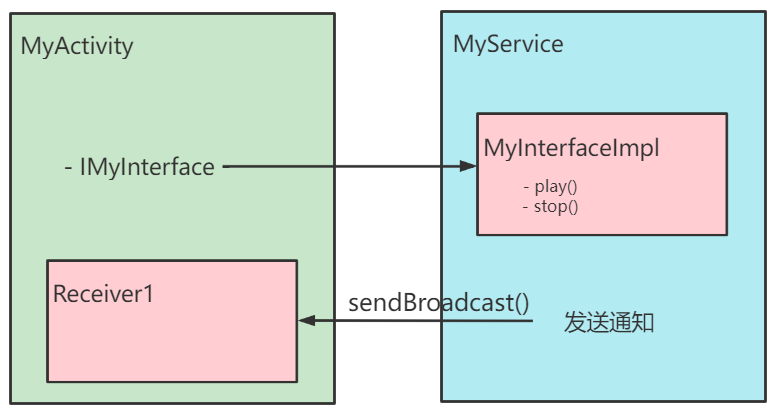1. 前言
最近对Android插件化开发比较感兴趣,也读了部分《Android插件化开发指南》这本书。在该书中1.4部分介绍了这么一句话:
我们曾天真地认为,Android插件化是为了增加新的功能,或者增加一个完整的模块。费了不少时间和精力,等项目实施了插件化后,我们才发现,插件化80%的使用场景,是为了修复线上bug。
我现在也粗浅的认为插件化是为了新增新的功能,至于修复线上bug这部分,确实还没有接触到或者说了解。希望后续自己能了解更多。
对于《Android插件化开发指南》这本书,我决定将其消化吸收了再整理博客笔记,因为确实写的比较好,有很多地方值得学习和借鉴。在这篇博客中,就简单的将书中2.15的例子展示出来,看看值得学习的点。
2. 实现一个音乐播放器APP
代码作者包老师也给出了源码地址,分别是:
感兴趣的可以直接看作者提供的源码。
2.1 设计思路一(一个Service和两个BroadcastReceiver)
- 音乐前台使用一个
Activity来展示歌曲信息; - 音乐后台播放,一般使用
Service来实现; - 用户交互至少需要提供开始和暂停按钮,无论点击那个按钮都是通知后台
Service播放或者停止音乐; - 当前音乐播放完毕,自动切换到下一首的时候,需要通知前台
Activity;
所以这个案例中至少需要一个Service和两个BroadcastReceiver。
首先是在MainActivity中简单定义两个按钮,并为这两个按钮提供发送广播(发送广播到Service)的方法。
btnPlay.setOnClickListener(new View.OnClickListener() {
@Override
public void onClick(View v) {
//send message to receiver in Service
Intent intent = new Intent("UpdateService"); // 传入Action
intent.putExtra("command", 1);
sendBroadcast(intent);
}
});
btnStop.setOnClickListener(new View.OnClickListener() {
@Override
public void onClick(View v) {
//send message to receiver in Service
Intent intent = new Intent("UpdateService"); // 传入Action
intent.putExtra("command", 2);
sendBroadcast(intent);
}
});
同时还需要提供一个BroadcastReceiver用来接受从Service发来的播放结束的广播消息。
// 用来接受Service发来的消息
public class Receiver1 extends BroadcastReceiver {
@Override
public void onReceive(Context context, Intent intent) {
status = intent.getIntExtra("status", -1);
int current = intent.getIntExtra("current", -1);
if (current >= 0) {
tvTitle.setText(MyMusics.musics[current].title);
tvAuthor.setText(MyMusics.musics[current].author);
}
switch (status) {
case 0x11:
btnPlay.setImageResource(R.drawable.play);
break;
case 0x12:
btnPlay.setImageResource(R.drawable.pause);
break;
case 0x13:
btnPlay.setImageResource(R.drawable.play);
break;
default:
break;
}
}
}
同时还需要在onCreate方法后面完成对上面Receiver1的注册:
receiver1 = new Receiver1();
IntentFilter filter = new IntentFilter();
filter.addAction("UpdateActivity"); // 可以收到action=UpdateActivity
registerReceiver(receiver1, filter);
因为在播放按钮中我们并没有启动后台Service,所以还需要在onCreate的后面完成:
Intent intent = new Intent(this, MyService.class);
startService(intent);
对于启动的MyService服务,播放完毕后需要发送广播到Activity:
mPlayer = new MediaPlayer();
mPlayer.setOnCompletionListener(new OnCompletionListener() {
@Override
public void onCompletion(MediaPlayer mp) {
current++;
if (current >= 3) {
current = 0;
}
prepareAndPlay(MyMusics.musics[current].name);
//send message to receiver in Activity
Intent sendIntent = new Intent("UpdateActivity");
sendIntent.putExtra("status", -1);
sendIntent.putExtra("current", current);
sendBroadcast(sendIntent);
}
});
为了接收从Activity中传入的信号(播放或者暂停),这里定义一个接收器:
public class Receiver2 extends BroadcastReceiver {
@Override
public void onReceive(final Context context, Intent intent) {
int command = intent.getIntExtra("command", -1);
switch (command) {
case 1:
if (status == 0x11) {
prepareAndPlay(MyMusics.musics[current].name);
status = 0x12;
}
else if (status == 0x12) {
mPlayer.pause();
status = 0x13;
}
else if (status == 0x13) {
mPlayer.start();
status = 0x12;
}
break;
case 2:
if (status == 0x12 || status == 0x13) {
mPlayer.stop();
status = 0x11;
}
}
//send message to receiver in Activity
Intent sendIntent = new Intent("UpdateActivity");
sendIntent.putExtra("status", status);
sendIntent.putExtra("current", current);
sendBroadcast(sendIntent);
}
}
让媒体播放器执行相应的方法,并把状态更新,传递到Activity。
当然这个Receiver2也需要在这个MyService中注册,为:
receiver2 = new Receiver2();
IntentFilter filter = new IntentFilter();
filter.addAction("UpdateService");
registerReceiver(receiver2, filter);
2.2 设计思路二(一个Service和一个BroadcastReceiver)
上面的逻辑比较清晰,就是A(Activity),B(Service)两个组件直接各自注册一个用来接收对方广播的接收器,然后收到消息后进行对应的逻辑处理。上面的流程可以简化为如下的图:

其实,很多音乐播放器只有一个Receiver,这是怎么实现的呢?
因为从上图可以看出,MyActivity和MyService的代码耦合度比较高,在学习设计模式中我们知道,为了解耦我们通常需要面向接口编程,而不是具体的实现。所以在《Android插件化开发指南》一书中作者使用了接口来进行解耦,从而替代从Activity向Service中发送广播的过程。如下图所示:
首先定义好接口:
public interface IServiceInterface {
public void play();
public void stop();
}
在Activity中定义一个IServiceInterface的实例:
IServiceInterface myService = null;
ServiceConnection mConnection = new ServiceConnection() {
public void onServiceConnected(ComponentName name, IBinder binder) {
myService = (IServiceInterface) binder;
Log.e("MainActivity", "onServiceConnected");
}
public void onServiceDisconnected(ComponentName name) {
Log.e("MainActivity", "onServiceDisconnected");
}
};
这里使用onBind方式,因为在ServiceConnection回调中可以得到一个IBinder对象,而这个对象是在Service的onBind中返回的,所以我们可以返回一个实现了IServiceInterface接口的IBinder对象,那么就可以得到接口的实现。在Activity中对应的将按钮的响应事件定义为:
btnPlay.setOnClickListener(new View.OnClickListener() {
@Override
public void onClick(View v) {
myService.play();
}
});
btnStop.setOnClickListener(new View.OnClickListener() {
@Override
public void onClick(View v) {
myService.stop();
}
});
当然在Activity中对应的定义广播接收器不变,一样需要注册这个广播接收器,并在最后启动定义的MyService服务。和前面的保持一致,这里就不再给出。
对于MyService这个类,才是本次的重点,因为在这个类中需要提供在onBind之后的返回对象,而我们需要让这个对象是接口的实例,故而定义如下:
// MyService类的内部类
private class MyBinder extends Binder implements IServiceInterface {
@Override
public void play() {
if (status == 0x11) {
prepareAndPlay(MyMusics.musics[current].name);
status = 0x12;
} else if (status == 0x12) {
mPlayer.pause();
status = 0x13;
} else if (status == 0x13) {
mPlayer.start();
status = 0x12;
}
sendMessageToActivity(status, current);
}
@Override
public void stop() {
if (status == 0x12 || status == 0x13) {
mPlayer.stop();
status = 0x11;
}
sendMessageToActivity(status, current);
}
}
其余的和前面的保持一致,也就是在播放完毕后发送广播通知Activity。
3.仿一个音乐播放器
从上面的两个案例中,感觉确实案例二更加优美。所以接下来继续尝试在这个案例剖析的基础上进行拓展。决定以酷狗音乐为例,来进行仿写试试。当然,写的过程将持续记录到这篇博客中。
Thanks
- 《Android插件化开发指南》